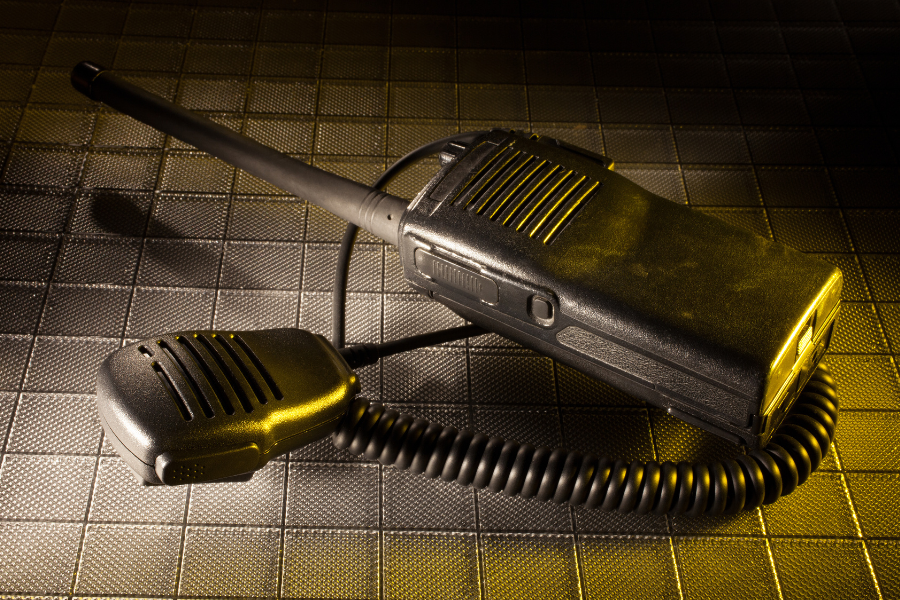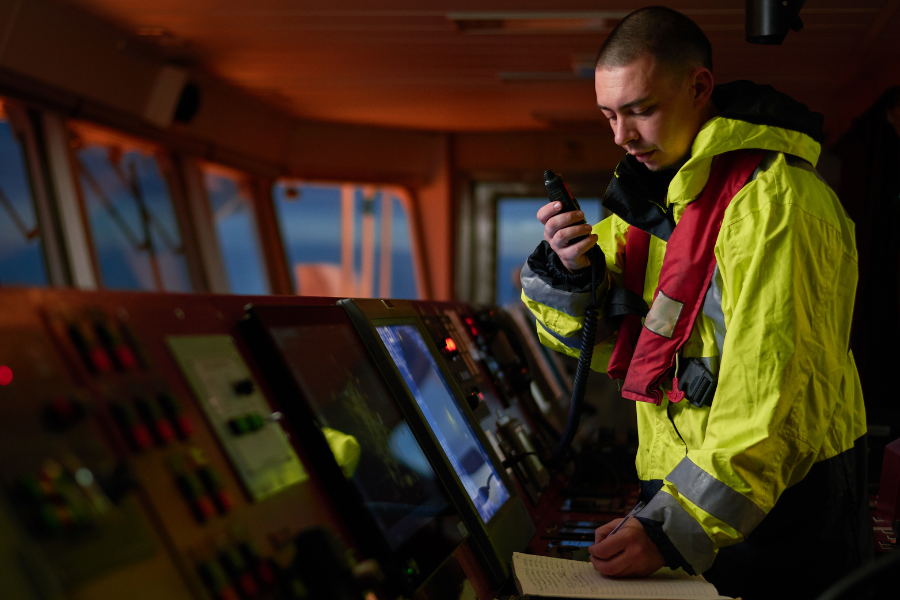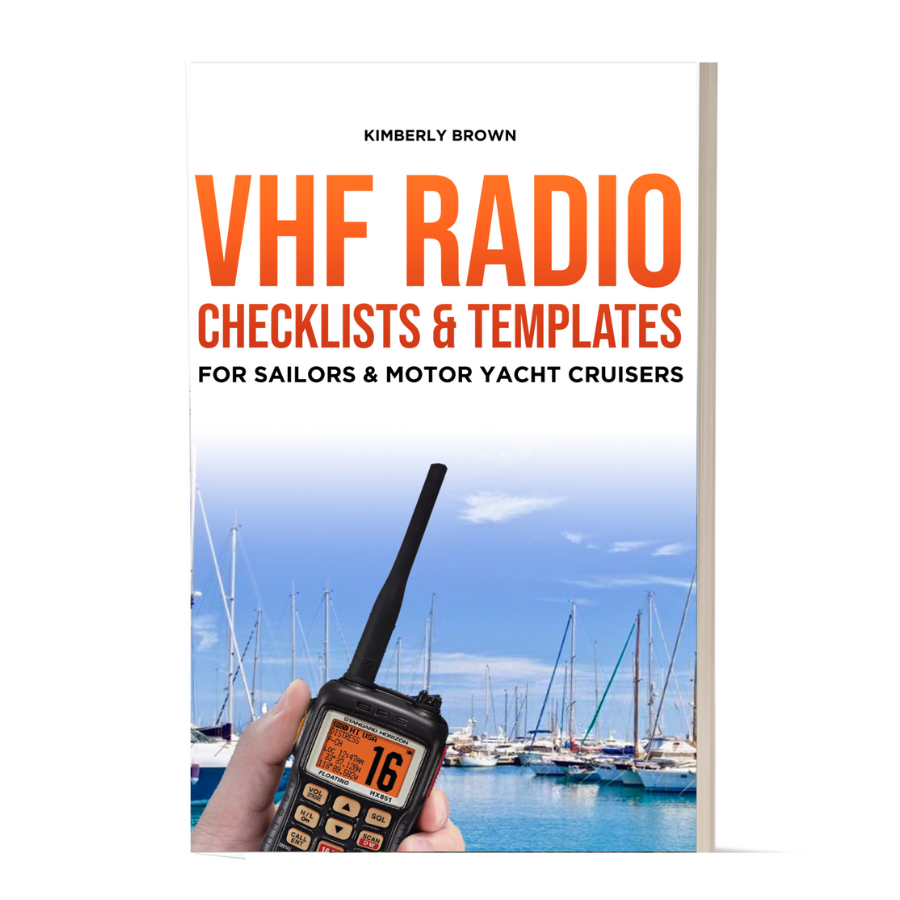For years I avoided taking a VHF Radio Course. I thought how hard could it be? Well, you don’t know what you don’t know.
My husband, Simon, took the VHF radio course and obtained a license when we first purchased our boat, so as long as one person had a license, I felt OK to let him hold all the knowledge.
I assumed I could quickly call up a marina and ask for a berth if I had to, so anything else would be similar. Yes? And if the worst-case scenario happened, and I had to make a MAYDAY call, I would push the scary red button on the radio and then follow the template taped to the underside of our navigation table left by the previous owner.

What if my husband went overboard?
However, deciding to sell up and sail worldwide made me think twice about my VHF radio knowledge. If I did have to do a MAYDAY, would I do it correctly, considering the panic situation I’d most likely be in? Would I know how to figure out where I am?
What if Simon wasn’t around and I received a DSC (Digital Selective Calling) alert – would I know how to respond? What is a DSC alert anyway? And what if our young daughter accidentally triggered the red button on the radio that is labeled ‘Distress’?
The most important thing about sailing is safety.
If our boat is going to go down, my husband, crew and I need to know exactly what to do. Furthermore, if someone else is in our vicinity and we can help to save lives, again, we need to know what to do.
My husband booked me on a VHF radio (marine) course.
The pain of not knowing or having confidence in using the VHF radio became uncomfortable. Simon booked me on a VHF radio course in Southampton, England. Steve Gravells from Technical Recreational Coaching led a class of nine of us.
Steve sent us the Royal Yachting Association (RYA) VHF radio course booklet a couple of weeks before the course, so we didn’t have to spend time learning the information from the book. If it weren’t for the homework that Steve requested before our class – a page of questions to be filled out – I would have failed to read the book. Again – I thought, ‘How hard can this be?’ Knowing I had homework to do, I read the book and did the homework.
The RYA VHF radio course booklet was beneficial.
Aside from the first couple of pages filled with acronyms (R&TTE, DSC, SRC, CEPT) that I knew I would never remember, the RYA book was straightforward and easy to read. It took 30 minutes to get through, and I was full of information when I finished.
Poor Simon had to listen to me say, “Did you know the word MAYDAY comes from the French word, M’aidez, and it means ‘help me’? And did you know that you need to send out a DSC (Digital Selective Calling) Alert before making a Pan-Pan voice broadcast?”
The VHF course was surprisingly enlightening!
Arriving at the Southampton Dry Stack after eating a bacon roll, I was eager to put the day behind me. I’ve never been a fan of courses. I get bored quickly, and I wouldn’t say I like a numb bum – the sensation you get when sitting too long.
Well, I was pleasantly surprised with the flow of the course. Never during the day did I wish that time would pass quickly. There was a mix of learning, watching, using the radio, coffee breaks, and general socializing. Everything taught was practical – it wasn’t theory or something that would go in one ear and out the other.
And it was so powerful to see the difference between learning how to use the radio and then using it.
Most of us seemed like we had it mastered, but when we went to (pretend) call another boat, the Coastguard, or make a MAYDAY, we found it more complicated than we thought.
***Make sure to get our FREE MAYDAY Template here: MAYDAY CHECKLIST & TEMPLATE
Ensuring to say who you are and whom you’re calling and finishing the message with the correct ‘over’ or ‘out’ wasn’t as easy as it looked! And talking slowly enough for others to write your MAYDAY was challenging. Not one person in the class spoke slowly enough for the other members to correctly note all the MAYDAY information.
Thankfully, by the end of the day, the whole class sounded much better than when we started. That’s because Steve would have us go through the call if we didn’t get it right.
To say that just my confidence increased would be an understatement.
My faith, knowledge, and the importance of the subject matter increased. Learning how to use the VHF radio is not about making sure you can call a marina to request a berth – it’s a device to potentially save your life and the lives of those in your area.
Until I took the course, I didn’t realize that the alarm that periodically went off on my boat was an urgent message alert. I didn’t know I was supposed to get a pen and paper to write down the follow-up voice distress message. I didn’t realize that I could potentially relay a message to the Coastguard on behalf of a boat that couldn’t transmit far enough for the Coastguard to hear.
Further, I didn’t know you could call another vessel through the DSC system if you have their MMSI (Maritime Mobile Service Identity) number. Finally, I didn’t think I could listen to multiple channels simultaneously–a dual-watch or triple-watch option.

Knowing that the majority of my readers are in America and won’t have the opportunity or access to a VHF radio course (A radio license is not required in the US), please allow me to provide some valuable information.
VHF Radio Course Highlights
- Make sure your safety equipment is working and routinely serviced. It’s an obvious one, but it’s imperative.
- Create Ship-to-Ship, MAYDAY, MAYDAY Relay, Received MAYDAY, Pan-Pan, Securite, Accidental Alert/DSC Cancelation, Request for Medical Help, Radio Check Request, Ship-to-Ship in heavy traffic as templates. Get them laminated and position them near the radio so anyone can pull them out and follow the instructions. (Get our FREE MAYDAY Template here: MAYDAY CHECKLIST & TEMPLATE)
- Put the name of your boat, call sign, and MMSI number in your templates and near the VHF radio so if a visitor has to use your radio, they know all the crucial details.
- Teach every guest on your boat how the radio works and where the templates are to activate the DSC system and make the appropriate follow-up calls.
- Ensure all the licenses are current and in your name (rather than the previous owner’s name). If a MAYDAY is triggered, the Coastguard might contact the emergency contact details registered on the license. You can imagine the implications if the previous owner hasn’t updated the license.
So, is a VHF radio course necessary to take?
My answer is a definite ‘Yes.’ Unfortunately, it’s one of those situations where you don’t know what you don’t know. By taking the course, you’ll increase your confidence in using a VHF radio, understand how to maneuver your way around the menu system, and, most importantly, understand what to do when an emergency strikes.
Overall, the VHF radio course is invaluable, and everyone in the boating community should take the course.
Whether you take a VHF course or not, it is very easy to forget how to instigate a DSC distress or urgency message and follow up with the correct broadcast message. Furthermore, remaining calm in a potentially life-threatening situation or emergency can be challenging.
By having quick, easy-to-understand, accessible instructions and broadcast templates, you make it easier for yourself to broadcast correctly and have a system that allows others who might not know how to use the VHF but are forced to do so.
Save yourself lots of time and effort!
If you’re not going to take a course or perhaps they’re not offered in your neck of the woods, do the next best thing – get my VHF Radio Checklists And Templates For Sailors guide. It’s packed with easy-to-understand tips and all the radio checklists and templates you’ll need to make calls.
Templates include calling another boat or place, using the DSC system, MAYDAY, MAYDAY relay, Pan Pan, Securite, canceling a VHF alert, receiving a MAYDAY transmission, or distress call, the phonetic alphabet, and numerals table. And the best thing about the offer is that you can get a customizable version.
After purchasing the guide you can request a Word Version so you can add your MMSI, Call Sign, and Boat name. You can then print and laminate custom-made templates that are ready to use in your Navigation Station. Get more information on the guide here: VHF Radio Checklists And Templates For Sailors
Other Articles or Videos You Might Be Interested In
- VHF Radio Marine for Sailing Cruisers
- How To Make A VHF Radio Call (Video)
- Request a FREE MAYDAY TEMPLATE
- Sending A Mayday
- Boat Safety & How To Keep Safe On The Water
- Boat Safety 101
Any Questions or Comments
Please leave them below.

Hi Kim,
Yes VHF Radio course important.
Imagine the circumstance where you are out and your engine fails (and if you’re sailing there is no wind), the tide is at full strength and you are quickly being carried backwards. What do you do?
You may have your mobile phone with you but who do you call? or what happens if you can’t get a signal (you may be in the shadow of a cliff or out of range) or you forgot to top your credits up?
Thanks
Maritime Training School